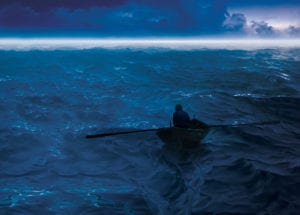By Daniel de la Calle
One learns and then works, and sometimes one’s work is learning. A few opportunities to do both:
≈A month-long research voyage in Scotland is using the latest robotic submersible technology to study the risks of Ocean Acidification to their deep coral colonies. The Mingulay coral reefs were only discovered ten years ago by a team led by Professor Murray Roberts, the person in charge of this expedition.
At the start of the voyage schoolchildren from Sgoil Lionacleit in Benbecula will visit the ship to watch the expedition’s robotic submarines explore the deep sea coral reefs growing on the Hebridean seabed. The team will also be working with the pupils and educational specialists from ‘Our Dynamic Earth’ in Edinburgh to develop environmental workshop materials for use in schools around Scotland.
Professor Murray Roberts says, “It’s the upcoming generations who are going to be the custodians of the natural world. This is an opportunity for young people to see with their own eyes the amazing underwater habitats that exist on their own doorstep.”
SOURCE
Take a minute to watch this great video about the Davidson Seamount, another deep sea coral area off the coast of California, to understand what makes these marine environments so special and discover what they look like:
SOURCE for video
≈In early May the College of Science and Engineering at San Francisco State University hosted their 14th annual Student Project Showcase. It featured more than 150 individual and group entries competing in the fields of Biological Science and Physical Science. “Graduate student Sara Boles explored the impact that rising acidity in oceans has on sea creatures. She placed oyster larvae into containers with varying temperatures and carbon dioxide levels and monitored them at three stages of development. She found that oysters in more intense environments — higher temperatures and carbon dioxide levels — needed to create more protein to deal with the environment, expending more energy in the process and making it difficult for them to survive. The results could suggest the effects of climate change on other species. “I’ve always been interested in human-caused activities and how they affect our environment,” Boles said. “Since we’re animals too, it’s really important to think of any other animals, like oysters, like a canary in a coal mine.””
SOURCE
≈A group of students at Montalvo Elementary School, in Ventura, California are participating in the NOAA’s Adopt a Drifter Program, tracking a 44-pound buoy across the sea after its release over a month ago off the Santa Barbara coast.
““[The students] will be able to predict and draw conclusions based on the data obtained after reviewing the buoy’s information,” said Jose Chicote, the fourth-grade teacher at Montalvo Elementary School whose class is involved in the study, “not to mention the new scientific terminology and math skills involved with this project.” […]
A unique component of the Adopt a Drifter Program is that students can follow buoy releases in other parts of the world and come together internationally: “The Adopt a [Drifter] Program is partnering with the International Preparatory School in Santiago de Chile, Chile,” said Chicote. “I believe this is a great opportunity for elementary school students to have a broader knowledge about communication between other students in different parts of the globe.””
“We have connections with kids in Chile, and when [the buoy] goes over to Chile, they get to see our names,” said student Aja Lim. “I feel so proud that our school can do all these cool things because this is something important.”
You might work at a school and want to adopt a drifter too. HERE IS THE LINK to the NOAA program site.
SOURCE
≈2 Year post-doctoral position within the European Free-Ocean Carbon dioxide Enrichment experiments (eFOCE) at the Laboratoire d’Océanographie de Villefranche (Villefranche-sur-mer, France).
“Responsibilities: The applicant will be in charge of running medium (few weeks) to longterm (several months) experiments in the bay of Villefranche-sur-Mer, focusing on the effects of ocean acidification on natural benthic communities (Posidonia beds and coralligenous algae). The experiments will be carried out in close collaboration with the eFOCE partners: Monterey Bay Aquarium Research Intitute (USA), Plymouth Marine Laboratory (UK), Station Biologique de Roscoff (France) and the Mediterranean Institute for Advanced Studies (Spain).” Deadline for application is June 24th, 2012.
READ HERE to find more.
≈Ph.D. scholarship at the School of Earth and Environmental Sciences of the University of Adelaide, Australia. They are looking for “an outstanding student interested in studying the interactive effects of Ocean Acidification and sea surface temperature rise on the physiology, behavior, and sensory ecology of larval fish. The project has a strong experimental component and is mainly laboratory-based.” The position is only open to international candidates outside of Australia and New Zealand. Applicants should have a M.Sc. degree or at least the equivalent of an Australian First Class Honors degree.
CONTACT HERE
SOURCE
≈During the life of this blog we have gone from no videos on Ocean Acidification to the dozens you can now find online. This new one is from the California Environmental Legacy Project.
≈A video animation by the Alliance for Climate Education that can serve as introduction for school children to Ocean Acidification.

